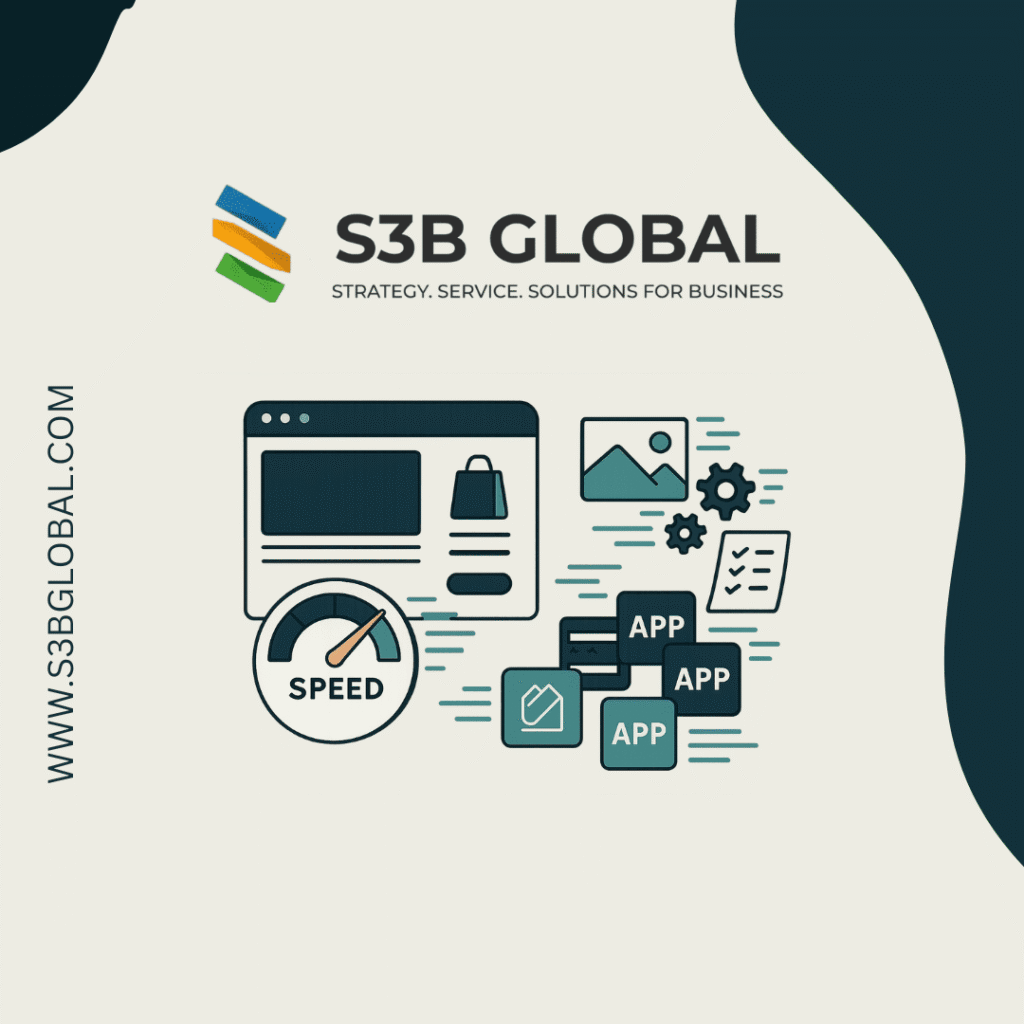
You’ve built a beautiful Shopify store — great products, crisp photography, and thoughtful copy. But if your pages load slowly, visitors get impatient and leave. Speed isn’t just a technical badge of honour; it’s the invisible sales assistant that either helps customers buy or quietly pushes them away.
At S3B Global, we approach Shopify optimization like quality-of-life work for both your store and your customers: faster pages, easier browsing, and higher conversion rates. Below are research-backed, human-friendly steps you can take right now — and the strategic playbook we use for deeper lifts.
Speed = revenue – the numbers you should care about
Faster sites convert better. Multiple studies show that pages that load in ~1 second convert significantly higher than pages that take 4–5 seconds. Shopify’s performance research highlights that fast pages can be 2.5–3× more likely to convert than slow pages. Improving even a fraction of a second can move the needle: a Deloitte study cited by Shopify found that a 0.1-second speed gain increased conversions by around 8.4%.
Average Shopify conversion benchmarks sit roughly between 1.4% and 1.8%, so improving speed is one of the highest-ROI actions to push your store up the percentile ladder.
The usual suspects — common speed killers on Shopify
Before we optimize, know what usually slows stores down:
-
Unoptimized images and video (large file sizes, wrong formats).
-
Too many third-party apps that inject scripts on every page.
-
Heavy themes or too many theme sections that load unneeded CSS/JS.
-
Uncontrolled fonts and webfonts (multiple weights + slow font loading).
-
Bloated tracking scripts / many pixels and tags.
-
No resource prioritization (critical CSS, preloading hero images, fonts).
Shopify’s own guidance recommends focusing on image sizing, app evaluation, and theme choices as the first line of defense.
Image & media — small file, big difference
Images are usually the biggest portion of a page’s weight. Practical, immediately actionable steps:
-
Deliver images sized exactly for their container (don’t upload a 3000px hero if it displays at 1200px).
-
Use modern formats (WebP where supported) and sensible compression; keep visual quality while cutting bytes.
-
Lazy-load below-the-fold images and defer offscreen video players.
-
Preload the hero image for above-the-fold speed gains.
Shopify’s 2025 image guidance shows updated best practices for WebP, responsive images, and lazy loading — these are low-effort, high-return optimizations.
S3B Global’s 6-step optimization playbook (practical & prioritized)
-
Audit (30–60 min): Run PageSpeed Insights / Lighthouse + Shopify speed report for homepage, product page, collection page. Identify obvious offenders (largest contentful paint, unused JS/CSS).
-
Image & media optimization (quick win): Resize, convert to WebP, set
srcset, and enable lazy loading on non-critical images. -
App triage: Disable apps that inject site-wide scripts. If an app is needed, load its script only on pages that require it or replace it with server-side alternatives.
-
Theme tuning: Reduce the number of dynamic sections on your most-visited templates; inline critical CSS, defer non-critical JS, and remove unused fonts.
-
Resource prioritization: Preload hero images, preconnect to critical domains (CDNs, payment providers), and optimize font-display to
swapor preload key font files. Recent guidance shows preloading critical resources noticeably helps Core Web Vitals. -
Measurement & iterate: Track Core Web Vitals and conversion lift (A/B test major changes). Optimization is ongoing — monitor, measure, and refine.
(If you want, we can run a no-cost 10-point audit of one page and show the top 5 fixes to apply.)
Conversion-focused tweaks — speed plus psychology
Speed lifts attention; conversion optimization nudges action. Combine both:
-
Streamline product pages: clear hero image, scannable benefits, single CTA above the fold.
-
Use skeleton loaders for slow components so users can interact while content finishes loading.
-
Simplify checkout flows (reduce steps, prefill where possible) — fewer clicks = fewer dropouts.
-
Sharpen trust signals (fast shipping, returns) near CTAs — perceived friction drops and conversions rise.
Remember: a fast store + clear path to purchase = compounding conversion gains.
Tools & checks (what we run and recommend)
-
Google PageSpeed Insights / Lighthouse (mobile + desktop)
-
Shopify Speed Report (theme + page-level insights)
-
WebPageTest for waterfall analysis and filmstrip view
-
Image compressors (local or automated via build pipeline) and WebP/AVIF converters
-
Tag manager for tracking control (load pixels server-side where possible)
Shopify’s enterprise content and Help Center give solid, platform-specific guidance worth following alongside these tools.
Quick checklist you can apply today (5–30 minutes)
-
Resize and convert your homepage hero image to WebP (or a responsive set).
-
Remove any unused apps (start by disabling, test, then uninstall).
-
Limit homepage dynamic sections — keep it focused and light.
-
Preload your hero image and main font.
-
Run PageSpeed Insights and note the Largest Contentful Paint (LCP) source.
Even a single quick win (like optimizing the hero image) can shave a second off load time and improve conversions noticeably.
Final thoughts
Optimizing a Shopify store is both technical and strategic. Quick wins bring immediate relief; disciplined measurement and code-level cleanup deliver lasting gains. At S3B Global, we blend research-backed tactics with a conversion-first mindset to ensure your speed improvements translate into real revenue uplift.
Want a tailored checklist for your store (homepage + a product page) and a prioritized action plan? Tell us the store URL and we’ll prepare a focused 10-point audit.
Email: info@s3bglobal.com
To know our Company . S3B Global
